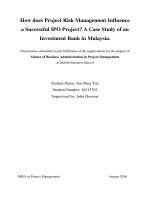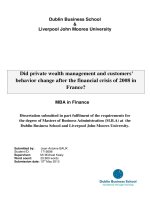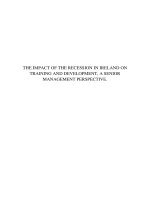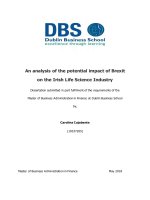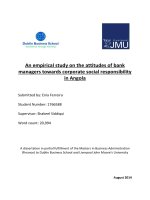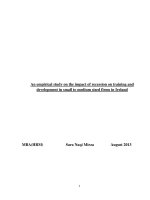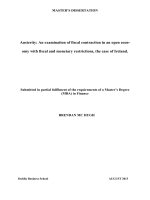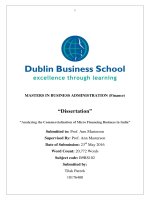Master Thesis in Economics: The case of French SMEs in the wine Industry going to ASEAN countries
Bạn đang xem bản rút gọn của tài liệu. Xem và tải ngay bản đầy đủ của tài liệu tại đây (662.3 KB, 91 trang )
!"#$%&'#(&)'%*&)+%,)'%*&$*-$./01
!"#$%&'()*+,-./
234567$43.670..$.89::5
;<=>?=@>;A
The
internationalization
of
SMEs
The
case
of
French
SMEs
in
the
Wine
Industry
going
to
ASEAN
countries
Author:
Céline
GAULTIER
1732934
Supervisor:
Dr
PJ
Paul
Level:
Master
of
Business
Studies
Submission
date:
16/08/2013
Words
count:
20,898
~
2
~
TABLE
OF
CONTENTS
List
of
illustrations................................................................................................................... p. 7
List
of
abbreviations ............................................................................................................... p. 8
Acknowledgements ................................................................................................................ p. 9
Abstract................................................................................................................................. p. 10
Chapter
1,
Introduction ........................................................................................................ p. 11
Chapter
2,
Literature
Review ................................................................................................ p. 14
2.1. The
French
SMEs
going
to
ASEAN
countries ........................................................... p. 14
2.1.1. The
ASEAN
countries..................................................................................... p. 14
2.1.2. The
French
Wine
industry ............................................................................. p. 18
2.2. International
marketing .......................................................................................... p. 19
2.2.1. Definition....................................................................................................... p. 19
2.2.2. The
eclectic
paradigm ................................................................................... p. 20
2.3. Internationalization
of
SMEs ................................................................................... p. 21
2.3.1. Definition....................................................................................................... p. 21
2.3.2. The
Uppsala
model ....................................................................................... p. 23
2.3.3. The
International
New
Ventures
theory ....................................................... p. 25
2.3.4. The
Network
theory ...................................................................................... p. 26
~
3
~
Chapter
3,
Methodology....................................................................................................... p. 30
3.1. Research
questions.................................................................................................. p. 30
3.2. Research
purpose .................................................................................................... p. 31
3.3. Research
objectives ................................................................................................. p. 31
3.4. Research
philosophies ............................................................................................. p. 32
3.4.1. Research
philosophy ..................................................................................... p. 33
3.4.2. Research
approach........................................................................................ p. 35
3.4.3. Research
strategy .......................................................................................... p. 36
3.4.4. Research
choice ............................................................................................ p. 37
3.4.5. Time
horizon ................................................................................................. p. 37
3.4.6. Data
collection
and
analysis .......................................................................... p. 38
3.5. Population
and
sampling ......................................................................................... p. 39
3.6. Plan .......................................................................................................................... p. 40
3.6.1. Practical
efforts
and
research
limitations ..................................................... p. 40
3.6.2. Personal
bias ................................................................................................. p. 40
3.6.3. Research
ethics ............................................................................................. p. 41
3.6.4. Time
allocation
.....................................................................................................
p. 41
3.7. Reliability
and
validity
.....................................................................................................
p. 42
3.8. Summary
of
the
methodology
used
.......................................................................
p.
43
~
4
~
Chapter
4,
Data
description
and
analysis ............................................................................. p. 44
4.1. General
information ................................................................................................ p. 44
4.2. Interview
description............................................................................................... p. 45
4.2.1. Interview
N°1,
Chateau
de
France ................................................................ p. 45
4.2.2. Interview
N°2,
Domaine
Fourrey .................................................................. p. 45
4.2.3. Interview
N°3,
Domaine
Dampt
Emmanuel.................................................. p. 46
4.2.4. Interview
N°4,
Domaine
Thierry
Richoux...................................................... p. 48
4.3. Data
analysis ............................................................................................................ p. 49
4.3.1. Summary
of
data ........................................................................................... p. 49
4.3.2. Data
analysis ................................................................................................. p. 49
4.3.2.1.
The
SMEs’
motivations
for
internationalize ...................................... p. 49
4.3.2.2.
Entry
modes
used
to
go
abroad ........................................................ p. 51
4.3.2.3.
Issues
encountered
when
internationalize ....................................... p. 52
4.3.2.4.
Is
there
an
activity
within
the
ASEAN
countries? ............................. p. 54
4.3.2.5.
The
current
situation
abroad ............................................................ p. 55
Chapter
5,
Research
findings ................................................................................................ p. 57
5.1. What
are
the
impacts
of
globalization
on
the
internationalization
of
SMEs? ....... p. 57
5.2. What
is
the
best
strategic
choice
for
the
French
SMEs
to
make
a
successful
internationalization? .............................................................................................. p. 58
5.3. How
to
know
if
the
internationalization
of
SMEs
is
successful
or
not? ................. p. 59
Chapter
6,
Conclusion ........................................................................................................... p. 63
6.1. Conclusion ............................................................................................................... p. 63
6.2. The
role
of
the
theories
and
how
they
describe
the
internationalization
process
of
SMEs ........................................................................................................................ p. 63
6.3. The
most
useful
aspects
of
the
theories ................................................................. p. 64
6.4. The
cyclic
model
of
the
internationalization
of
SMEs
............................................ p. 65
~
5
~
Chapter
7,
Self-‐Assessment
on
Own
Learning...................................................................... p. 70
7.1. Introduction ............................................................................................................. p. 70
7.2. Reflection
on
Learning............................................................................................. p. 70
7.2.1. Definition....................................................................................................... p. 70
7.2.2. Relationships
between
Reflection
and
Learning .......................................... p. 71
7.2.3. The
Experiential
Learning
Theory
(ELT) ....................................................... p. 72
7.3. Skills
development................................................................................................... p. 74
7.3.1. Research
capabilities
and
analytical
skills ..................................................... p. 74
7.3.2. Communication
and
language
skills.............................................................. p. 74
7.3.3. Academic
knowledge .................................................................................... p. 75
7.3.4. Team
working
skills
and
working
methodology ........................................... p. 76
7.3.5. Time
management
skills ............................................................................... p. 77
7.4. Future
directions ..................................................................................................... p. 77
Bibliography .......................................................................................................................... p. 79
Appendices ........................................................................................................................... p. 88
Appendix
A,
Interview’s
questions
..........................................................................
p.
89
Appendix
B,
The
Confidentiality
Agreement
...........................................................
p.
90
Appendix
C,
The
Informed
Consent
Form
...............................................................
p.
91
~
6
~
LIST
OF
ILLUSTRATIONS
Figure
1,
The
ASEAN
flag....................................................................................................... p. 14
Figure
2,
The
ASEAN
countries
map ..................................................................................... p. 15
Figure
3,
The
Uppsala
model,
state
and
change
aspects ..................................................... p. 24
Figure
4,
Internationalization
and
the
network
theory ........................................................ p. 27
Figure
5,
The
Research
Onion ............................................................................................... p. 32
Figure
6,
The
differences
between
Deduction
and
Induction
approaches
in
research
methods
.............................................................................................................................................. p. 35
Figure
7,
Time
Schedule
......................................................................................................
p.
41
Figure
8,
Summary
of
the
methodology
used
.....................................................................
p.
43
Figure
9,
Information
about
the
SMEs’
interviewees ........................................................... p. 44
Figure
10,
Summary
of
the
interviews ................................................................................. p. 49
Figure
11,
The
experiential
learning
cycle ............................................................................ p. 73
~
7
~
LIST
OF
ABBREVIATIONS
DBS:
Dublin
Business
School
SMEs:
Small-‐to-‐
Medium
Enterprises
MNEs:
Multi-‐National
Enterprises
FDI:
Foreign
Direct
Investment
ASEAN:
Association
of
the
South
East
Asian
Nations
INVs:
International
New
Ventures
CEO:
Chief
Executive
Officer
ELT:
Experiential
Learning
Theory
~
8
~
ACKNOWLEDGEMENTS
Throughout
my
work
on
this
dissertation,
many
people
have
supported
and
helped
me
in
various
ways.
My
thank
goes
to
all
of
them.
I
wish
to
thank
all
those,
who
participated
in
the
empirical
study
of
this
thesis.
Without
the
information
they
shared,
this
research
would
not
have
been
possible.
On
the
one
hand,
my
thanks
go
to
Clotilde
&
Philippe,
and
also
Christophe
FLOUZAT,
who
helped
me
to
find
Wine
growers
for
my
interviews.
On
the
other
hand,
I
wish
to
thank
the
four
interviewed
SMEs,
in
particular
their
CEO
(Arnaud
THOMASSIN,
Marie-‐José
FOURREY,
Emmanuel
DAMPT
and
Thierry
RICHOUX),
who
shared
their
details,
rich
knowledge
and
experiences
with
me.
Their
insight
has
greatly
enriched
my
understanding
of
internationalization
process
of
SMEs
and
improved
the
study.
I
would
like
to
thank
you
my
supervisor,
P.J
PAUL,
for
his
understanding
of
my
situation
and
his
capacity
to
respond
to
my
questions
in
a
very
useful
and
quick
way.
He
provided
me
guidance
and
support
to
improve
the
quality
of
my
dissertation.
For
numerous
discussions
of
topical
matters,
I
would
like
to
thank
my
friend
Athénaïs
without
whom
the
choice
of
the
topic
would
have
been
much
more
difficult.
She
has
known
to
help
me
to
find
the
right
topic,
in
other
terms
the
topic
that
interests
me
for
writing
this
whole
dissertation.
And,
my
heartful
thanks
go
to
my
family
for
their
support
and
help
during
all
the
dissertation
process.
I
would
like
to
thank
my
parents,
Evelyne
and
Eric
for
supporting
me
during
my
entire
studies,
and
especially
for
giving
me
the
chance
to
go
at
the
Dublin
Business
School
for
my
last
year
of
studies.
I
would
also
like
to
acknowledge
my
sister,
Marine,
for
her
support
and
help
with
the
form
and
structure
of
this
dissertation.
Lastly,
I
wish
to
thank
my
friend
Alexandre
for
his
unconditional
support
every
day,
and
for
the
careful
proofreading
he
has
had
for
my
thesis.
~
9
~
ABSTRACT
Nowadays,
the
concept
of
globalization
seems
reduced
to
the
size
of
the
market
and,
export
is
only
one
aspect
of
the
phenomenon
of
globalization.
In
global
industries,
it
is
now
the
most
competitive
positions
and
bases
of
competitiveness
which
should
be
established
worldwide.
Therefore,
globalization
raises
strategies
to
become
more
global
rather
than
local.
Those
strategies
consist
in
expanding
and
coordinating
all
activities
of
the
company
worldwide.
In
a
first
time,
to
understand
why
SMEs
internationalize,
the
researcher
will
deal
with
the
traditional
model
of
the
internationalization
of
firms
(the
Uppsala
model).
And
then,
more
recently,
new
models
of
internationalization
have
been
developed.
These
models,
created
following
an
increase
of
the
extent
of
the
phenomenon
of
the
International
New
Ventures,
revolve
around
the
concepts
of
resources
and
skills,
network
and
knowledge.
In
a
more
recent
context
of
economic
globalization
and
competition,
some
SMEs
establish
real
strategies
of
globalization,
particularly
by
inserting
themselves
in
network
(the
Network
theory).
This
is
therefore
necessary
in
this
research
to
broaden
the
issue
of
the
internationalization
of
SMEs,
which
is
too
often
reduced
to
export.
Based
on
these
three
theories
(the
Uppsala
model,
the
Network
theory
and
the
International
New
Ventures
theory),
this
research
will
bring
to
SMEs,
in
particular
French
SMEs
in
the
Wine
industry,
a
range
of
different
modes
of
internationalisation.
This
range
will
also
allow
to
French
SMEs
in
the
Wine
industry
to
make
decision
and
choose
more
confidently
as
for
the
entry
mode
it
will
use
to
go
into
a
South
East
Asian
market.
Key
words:
internationalization,
the
Uppsala
model,
and
the
network
theory,
SMEs
~
10
~
CHAPTER
1,
INTRODUCTION
The
trend
toward
globalization
of
markets
is
likely
to
become
increasingly
important
in
the
21st
century.
So,
in
today’s
globalized
world,
the
domestic
economy
is
dependent
on
external
markets
to
grow.
This
has
made
firms’
international
activities
even
more
important
to
the
economic
development
of
nations.
In
this
context,
the
issue
relating
to
the
development
of
the
best-‐suited
international
marketing
strategies
that
allow
for
successful
competition
in
foreign
markets
is
particularly
relevant
(Q.
Tan
&
C.
M.P.
Sousa,
2012).
Therefore,
to
prove
to
French
small
to
medium
size
enterprises
(SMEs)
in
the
Wine
Industry
that
it
is
important
to
internationalize
the
researcher
conducting
this
research.
Since
the
last
three
decades,
the
interest
for
the
SMEs
has
become
a
global
phenomenon.
This
interest
is
reflected
in
the
recognition
of
the
multi-‐national
enterprises’
(MNE)
legitimacy
as
a
research
topic
itself.
SMEs
are
no
longer
considered
as
miniatures
of
multinationals
and
their
study
is
a
separate
field
of
the
French
economy
(Laghzaoui,
2009).
SMEs
are
major
actors
of
globalization
and
their
internationalization
represents
the
economic
stakes
in
terms
of
innovation,
employment
and
international
dynamism
of
a
country.
That
is
why
it
is
important
for
a
SME
to
develop
all
or
part
of
its
activity
internationally.
Nowadays,
two
main
factors
forcing
SMEs
to
internationalize:
in
one
hand,
there
is
the
Chinese
threat
on
the
French
Wine
Industry,
and
on
the
other
hand,
there
is
the
explosion
of
the
global
consumption
and
the
decrease
of
the
French
consumption
(France-‐Monde,
“Vinexpo
face
aux
défis
de
la
mondialisation”,
2013).
According
to
a
study
conducted
by
Vinexpo
(the
French
Wine
Exposition,
2013),
the
worldwide
consumption
expected
to
grow
by
5,3%
between
2012
and
2016.
However,
the
French
SMEs
are
struggling
to
develop
all
or
part
of
their
activity
abroad
(Bourcieu,
2012).
French
SMEs
have
some
difficulties
in
understanding
foreign
markets
because
they
do
not
always
have
the
language
and
intercultural
skills
for
that.
Moreover,
they
might
not
know
all
the
ways
to
internationalize
their
activity.
~
11
~
So,
this
research
will
be
based
on
the
following
overall
question,
“Which
ways
of
internationalization
French
SMEs
could
adopt
to
expand
their
activity
abroad,
particularly
in
South
East
Asia
(ASEAN)?”
The
idea
here
is
to
prove
to
French
SMEs
that
there
are
several
ways
of
internationalization.
Export
is
the
best
known
and
most
practiced,
but
there
are
several
other
ways
of
internationalization.
And,
it
would
be
interesting
for
French
SMEs
to
know
all
these
ways.
So,
the
purpose
of
this
research
is
to
find
out
the
best
suited
strategic
choice
for
French
SMEs,
in
the
Wine
Industry,
that
are
going
to
ASEAN
countries.
The
scope
of
the
research
is
the
French
SMEs
in
the
Wine
Industry
that
are
going
to
ASEAN
countries.
This
research
will
not
be
extended
to
China.
And,
there
will
have
three
limitations:
time
management,
the
transcriptions
of
interviews
that
will
be
in
French,
and
the
access
to
companies.
This
study
will
be
based
on
the
knowledge
and
experiences
that
the
researcher
has
acquired
during
her
five
years
of
study.
Curiosity
and
the
desire
to
discover
allow
to
the
researcher
to
conduct
this
research
by
adopting
an
interpretivism
and
subjectivist
philosophy
within
an
inductive
approach
using
qualitative
data
through
interviews
(multi-‐method).
The
main
purpose
of
this
research
is
to
show
to
French
SMEs
in
the
Wine
Industry
that
there
exists
many
ways
to
develop
their
activity
abroad.
The
researcher
will
intend
this
objective
by
meeting
four
French
Wine
growers.
This
dissertation
is
composed
in
seven
chapters.
The
first
chapter
is
the
introduction.
In
the
second
chapter,
the
researcher
will
explain
different
theories
of
internationalization
(the
UPPSALA
model,
the
Network
theory
and
the
INV
theory).
These
theories
appear
in
a
chronological
order.
In
chapter
three,
all
the
methodology
used
for
this
research
will
be
described
and
explained.
Then,
for
the
chapter
four,
the
researcher
will
describe
and
analyse
the
data.
In
chapter
five,
the
researcher
will
link
the
findings
found
with
the
research
questions.
In
chapter
six,
the
researcher
will
present
the
conclusions
about
these
theories
and
ways
of
internationalization,
and
will
make
some
recommendations
for
SMEs
in
every
industry.
And
finally,
in
chapter
seven,
a
self-‐reflection
on
own
learning
and
performance
of
the
researcher
will
be
made.
~
12
~
This
research
will
be
addressed
mainly
to
French
SMEs
within
the
Wine
Industry,
which
would
like
to
develop
their
activity
in
a
foreign
market.
But,
it
will
also
be
useful
for
any
SMEs
of
any
industry.
Moreover,
all
managers,
whatever
the
size
of
their
organization,
could
be
interested
by
this
research
to
have
a
better
understanding
of
the
internationalization
process.
And,
as
the
dissertation
report
will
be
recorded
in
the
Dublin
Business
School
database,
future
DBS
Master’s
student
might
be
interested
by
this
research,
and
also,
students
from
the
Liverpool
John
Moores
University,
which
is
the
partner
university.
Finally,
of
course,
the
researcher
benefits
from
this
dissertation
on
both
personal
and
professional
points
of
view.
In
the
one
hand,
the
researcher
can
use
this
study
as
a
“plus”
during
her
job
interviews;
and
on
the
other
hand,
the
researcher
learnt
lots
of
things
by
doing
this
study
as
conducting
a
whole
research
alone,
so
it
has
developed
her
interpersonal
skills.
~
13
~
CHAPTER
2,
LITERATURE
REVIEW
In
this
chapter,
the
researcher
will
present
the
theoretical
framework
that
is
considered
to
be
relevant
for
this
study.
The
chapter
is
based
on
presenting,
in
a
first
time,
the
context
and
the
unit
of
analysis,
and
then,
on
the
theories
concerning.
2.1.The
French
SMEs
going
to
ASEAN
countries
2.1.1. The
ASEAN
countries
An
important
force
in
the
Pacific
is
the
ASEAN
(the
Association
of
South
East
Asian
Nations),
which
was
established
in
1967
primarily
as
a
regional
instrument
of
economic,
social
and
cultural
cooperation
to
enhance
cohesion,
self-‐reliance
and
“resilience”
(Randolph,
1984).
Figure
1,
the
ASEAN
countries
flag
This
association
(see
the
flag
above,
figure
1)
was
established
on
8th
August,
1967
in
Bangkok,
Thailand
with
the
signing
of
the
ASEAN
Declaration
by
the
founding
fathers
of
ASEAN,
namely
Indonesia,
Malaysia,
Philippines,
Singapore
and
Thailand.
And
then,
years
after
years,
several
countries
joined
these
countries
such
as
Myanmar,
Laos,
Vietnam,
Cambodia,
Brunei,
Indonesia
and
Burma
as
shown
in
Figure
2.
~
14
~
Figure
2,
the
ASEAN
countries
map.
Here,
there
is
a
limitation
for
the
researcher
due
to
the
religion
of
these
countries.
Indeed,
most
of
them
are
Muslim.
So,
the
researcher
must
pay
attention
to
study
the
right
country
because
of
the
context
of
this
research,
the
Wine
Industry.
So,
it
is
interesting
to
know
why
these
countries
have
interested
the
researcher,
and
to
understand
what
characteristics
the
South
East
Asian
countries
have.
The
French
SMEs
bet
on
the
ASEAN
countries
to
revive
their
growth.
Indeed,
ASEAN
countries
are
the
future
Eldorado
of
Wine
producers.
Asian
conquest
is
already
underway
and
the
competition
between
different
actors
seems
to
be
very
fierce.
Singapore,
which
represents
a
huge
part
of
French
exports,
acts
as
a
platform
for
forwarding
French
Wine
in
the
other
ASEAN
countries,
which
enjoy
lower
tariffs.
Singapore
is
seen
as
a
strategic
position
in
the
heart
of
South
East
Asia.
Indeed,
after
Chine
and
Japan,
this
city
is
the
third
Asian
destination
for
the
French
products,
and
especially
for
the
French
Wine.
In
2011,
France
exported
for
€5,1
billion
in
Singapore.
But,
despite
a
downturn
(forecast
from
1%
to
3%
for
this
year),
the
State-‐city
still
import
for
its
own
consumption,
but
also
to
~
15
~
redirect
towards
the
ASEAN
countries.
This
is
a
huge
hub:
50%
of
imported
products
are
distributed
in
South
East
Asia.
So,
sell
to
Singapore
is
like
to
sell
to
South
East
Asian
countries.
Moreover,
other
countries
such
as
Malaysia,
Vietnam,
Indonesia
and
Taïwan
have
a
French
Wine
consumption
growth,
which
double
every
year.
Malaysia
is
one
famous
developing
country
explicitly
supporting
SMEs
to
be
globally
connected.
A
multi
ethnic
and
polyglot
country,
Malaysia
has
major
advantages
of
being
political
stable
with
first
class
physical
infrastructure.
Moreover,
Malaysia
is
competitive
in
attracting
direct
foreign
investments,
and
this
is
among
the
world’s
top
20
trading
nations
(the
NST,
2006).
So,
Malaysia
is
one
of
the
most
stable
countries
in
South
East
Asia,
which
favours
many
of
the
investors.
SMEs
of
the
French
Wine
industry
are
beginning
to
show
results
in
this
region
(P.
Monthly,
2012).
Indeed,
SMEs
are
considered
in
South
East
Asia
to
be
a
key
driver
of
economic
growth.
Growth
has
been
used
as
a
modest
measure
of
success
and
performance
in
business
and
Delmar
et
al
(2003)
also
insinuated
that
it
is
an
appropriate
indicator
for
surviving
SMEs.
So,
they
are
recognised
as
being
one
of
the
main
driving
forces
in
economic
development.
SMEs
are
also
flexible
and
can
adapt
quickly
to
changing
market
demand
and
supply
situations.
In
due
process,
those
SMEs
generate
employment,
help
diversify
economic
activity
and
make
a
significant
contribution
to
exports
and
international
trade
(Ahmad,
2011).
Moreover,
ASEAN
government
and
especially,
Malaysian
government
are
ready
to
pay
so
much
attention
to
those
French
SMEs.
And,
they
are
ready
to
help
those
SMEs
in
their
development
and
growth.
That
is
the
reason
why
it
is
very
important
for
the
French
SMEs
in
the
Wine
industry
to
develop
their
activity
in
this
part
of
the
world.
After
Malaysia,
French
SMEs
in
the
Wine
industry
steer
a
course
for
Vietnam.
Indeed,
Vietnam
is
full
of
business
opportunities.
Two
factors
promote
exchanges
between
France
and
Vietnam.
In
one
hand,
the
local
market
is
saturated.
Indeed,
the
local
consumption
declined
since
1960,
French
people
drink
less
Wine
and
their
habits
and
tastes
change.
~
16
~
That
is
why
French
SMEs
in
the
Wine
industry
have
an
interest
in
developing
their
activity
abroad,
and
especially
in
ASEAN
countries.
And
on
the
other
hand,
there
is
a
strong
cultural
relation
between
France
and
Vietnam
due
to
colonization.
So,
it
is
preferable
for
French
SMEs
to
go
in
Vietnam
rather
than
another
country.
Indeed,
today
is
the
best
time
to
take
an
interest
in
Vietnam;
the
middle
class
is
under
constant
development
and
young
people
are
looking
for
something
new
(Brick,
2013).
Moreover,
Vietnamese
seek
to
reduce
their
dependence
on
China,
and
thus
attract
investors
in
logic
of
transfer
of
technology
in
order
to
manufacture
products
locally
with
higher
added
value
(Lecourtier,
2013).
And
finally,
French
SMEs,
wishing
to
expand
into
new
local
markets,
considering
Vietnam
as
an
access
door
to
all
the
ASEAN
countries.
“Vietnam
could
be
a
rear
base
to
target
countries
like
Singapore”
(Lamarre,
2013).
To
sum
up,
it
seems
essential
to
notice
that
2013
is
the
year
for
France
in
Vietnam.
A
spotlight
will
be
given
to
this
country,
which
is
considered
as
one
of
the
most
promising
areas
in
Asia.
With
an
increasing
average
purchasing
power,
the
opportunities
in
the
Wine
industry
are
significant.
Taiwan
is
seen
as
a
place
to
take
for
business.
Indeed,
the
third
Asian
economy
attracts
relatively
few
French
people.
In
the
shadow
of
its
big
neighbour
China,
Taiwan
showed
3%
growth
this
year.
The
SMEs
in
the
French
Wine
industry
has
an
excellent
image
to
exploit
in
this
country.
Another
country,
that
does
not
do
much
in
France,
is
Indonesia.
However,
with
7%
growth
per
year,
this
is
one
of
the
most
dynamic
economies
in
this
region.
So,
ASEAN
countries
are
perceived
such
as
a
priority
of
the
French
Foreign
Trade.
Indeed,
the
French
market
share
reaches
at
its
maximum
1,5%
in
this
region,
while
the
ASEAN
countries
show
growth
rate
above
5%.
This
area
shows
a
lot
of
interests
and
opportunities
for
the
French
SMEs
of
the
Wine
industry.
Moreover,
this
observed
phenomenon
of
the
French
Wine
in
the
ASEAN
countries
is
the
consequence
of
a
phenomenon
of
Westernization.
With
the
increase
of
the
buying
power
and
the
standards
of
living,
Asian
youth
aspire
to
Western
luxury.
The
French
Wine
is
very
appreciated
by
South
East
Asian
people
because
it
embodies
the
tradition,
refinement
and
romanticism.
And
red
Wine
is
much
more
appreciates
because
by
its
colour
it
represents
luck,
fortune
and
love,
which
are
important
symbols
in
these
countries.
~
17
~
2.1.2. The
French
Wine
industry
Wine
is
an
integral
part
of
the
French
culture,
the
French
heritage
and
the
French
economy
for
centuries.
Wine
is
more
than
a
farm
product
or
a
raw
material
that
it
sells
to
or
buys
from
foreign
markets.
Wine
and
food
could
be
a
good
association
for
a
meal.
But,
it
should
not
always
associate
Wine
with
food
because
Wine
represents
much
more
than
that.
Indeed,
Wine
has
a
cultural,
historical
and
a
heritage
dimension.
France
is
the
first
country
in
the
world
for
Wine
production
in
volumes,
for
the
value
of
its
exports,
for
the
consumption
and
the
product
diversity.
The
balance
of
the
trade
balance
showed
a
surplus
of
€6
billion
in
2007.
Wine
growing
is
the
ambassador
of
the
French
farm
power.
Indeed,
it
represents
an
example
that
all
the
other
countries
in
the
world
envy
for
its
tradition,
qualities
and
its
authenticity.
Nowadays,
the
French
Wine
growing
is
at
a
turning
point
of
its
history,
and
with
the
apparition
of
the
Wine
of
the
“New
World”
(North
America,
South
Africa,
Chile
and
Australia),
consumer
taste
change
and
lifestyles
evolve.
Indeed,
the
French
consumption
was
halved
in
25
years.
While
the
Wine
was,
in
1980,
a
daily
drink
for
50%
of
French
people,
today
only
20%
of
them
drink
Wine
regularly
(Bastian
2008).
So,
the
French
SMEs
should
adapt
themselves
to
this
new
context.
They
must
become
more
competitive
while
remaining
authentic.
Indeed,
the
global
context
is
much
better:
the
global
consumption
of
Wine
increases.
For
Bastian
(2008),
the
French
Wine
growing
has
strengths
to
challenge
the
future.
There
is
a
huge
potential:
various
regions,
a
suitable
climate,
Winemakers
and
Winegrowers
their
incomparable
know-‐how
and
a
worldwide
known
image.
The
EU
Wine
sector
is
the
largest
in
the
world.
With
an
annual
production
of
175
million
of
hectolitres,
it
represents
45%
of
the
Wine-‐growing
areas
of
the
world.
France
represents
32%
of
the
European
production.
France
is,
nowadays,
the
largest
Wine
producer
in
the
world.
In
2011,
the
Wine
Industry
in
France
had
a
turnover
of
11
billion
of
Euros
(European
Commission,
2011).
~
18
~
But,
some
studies
show
that
the
Wine
production
has
declined
steadily
since
1960
(European
Commission,
2011).
And,
at
the
same
time,
the
share
of
the
top
five
new
producers
(United
States,
Argentina,
Chile,
Australia
and
South
Africa)
has
doubled
in
six
years.
In
the
article
“The
Wine
is
always
a
major
player
in
the
French
economy”
from
the
French
newspaper
Le
Parisien,
it
is
explained
that
the
French
Wine
producers
are
forced
to
export.
Here,
there
is
a
gap
for
the
researcher.
In
fact,
the
researcher
will
find
out
several
other
choices
for
the
SMEs,
which
would
like
to
develop
their
activity
abroad.
So,
in
a
context,
which
is
more
and
more
tough
(increased
world
production,
overall
consumption
down
and
heavy
competition),
it
will
be
necessary
for
the
French
Wine
producers
to
resort
to
international
marketing.
Even
if
the
quality
remains
essential,
it
is
no
longer
enough.
Indeed,
it
is
over
here
to
sell
a
product,
and
the
French
Wine
producers
should
be
able
to
sell
their
“know-‐produce”.
So,
in
this
research,
many
concepts
and
theories
will
be
highlighted
to
find
out
the
best
strategic
choice
to
sell
this
“know-‐produce”
in
ASEAN
countries.
2.2.International
Marketing
2.2.1. Definition
The
internationalization
of
marketing
began
to
appear
at
the
end
of
the
1990s
with
the
shifts
of
the
economical
environment
in
the
world.
But
the
question
of
the
international
trade
was
firstly
addressed
by
the
French,
Jacques
Savary
through
his
book
“Le
parfait
Négociant”
(“the
perfect
trader”)
in
1679.
He
presented
the
conditions
for
implementing
a
trade
activity
abroad.
From
here,
several
authors
gave,
years
after
years,
their
own
definition
of
the
international
marketing.
For
Doole
and
Lowe
(2001),
there
are
two
levels
of
international
marketing,
“At
its
simplest
level,
international
marketing
involves
the
firm
in
making
one
or
more
marketing
mix
decisions
across
national
boundaries.
At
its
most
complex
level,
it
involves
the
firm
in
establishing
manufacturing
facilities
overseas
and
coordinating
marketing
strategies
across
the
globe”.
~
19
~
For
Keegan
(2002),
“the
international
market
goes
beyond
the
export
marketer
and
becomes
more
involved
in
the
marketing
environment
in
the
countries
in
which
it
is
doing
business”.
Keegan’s
definition
is
typical
one
of
those
that
see
international
marketing
as
one
stage
of
an
internationalization
process.
From
these
definitions,
several
authors
established
some
theories
and
models
(the
eclectic
paradigm,
the
UPPSALA
model,
the
Network
theory
and
the
INVs
theory)
to
understand
the
internationalization
of
SMEs.
2.2.2. The
eclectic
paradigm
According
to
Johanson
and
Vahlne
(1990),
one
of
the
most
accepted
scopes
of
internationalization
based
on
the
theory
of
foreign
direct
investments
(FDI)
is
the
eclectic
paradigm
of
Dunning
(1988).
The
eclectic
paradigm
aims
to
explain
international
production
of
the
multinational
corporation.
Studying
the
international
activities
of
multinational
corporations,
there
is
an
intersection
between
macroeconomic
international
trade
theory
and
microeconomic
theory
of
the
firm
(Dunning,
1993).
In
accordance
with
Ruzzier
et
al
(2006)
and
Noel
(2009),
the
eclectic
paradigm
is
also
known
as
the
OLI
paradigm
based
on
the
Ownership,
Location
and
Internationalization
advantages
of
a
firm.
Determining
these
advantages,
the
model
answers
why,
how
and
where
foreign
direct
investments
should
be
undertaken.
The
ownership
advantages
are
why
the
firm
should
go
abroad.
For
example,
in
Vietnam,
where
the
young
population
is
looking
for
new
tastes,
new
ways
of
consumption
within
the
Wine
industry.
The
location
concerns
where
to
establish
abroad
and
what
advantages
certain
foreign
markets
can
offer
to
the
firm.
Lastly,
the
internationalization
advantages
decide
if
the
firm
should
conduct
international
expansion
within
the
firm
through
FDI
or
if
it
should
be
externalized
through
for
example
an
agent.
~
20
~
So,
the
advantages
presented
in
this
paradigm
allow
the
firm
to
decide
on
the
most
appropriate
way
to
internationalize.
The
eclectic
paradigm
might
thus
use
as
a
tool
of
analysis
for
managers
who
want
to
know
the
best
entry
mode
in
a
foreign
market.
But,
the
OLI
paradigm
is
also
criticized
for
a
limited
predictive
power
due
to
ignoring
the
objectives
of
the
firm,
the
decision
maker
and
the
surrounding
environment
(Mtigwe,
2006).
Moreover,
in
accordance
with
Melin
(1992),
the
eclectic
paradigm
remains
static.
Indeed,
the
paradigm
explains
the
presence
of
MNEs
who
want
to
benefit
by
the
OLI
advantages,
but
fails
to
explain
the
process
by
which
these
firms
internationalize.
And,
Johanson
and
Mattsson
(1988),
mentioned
by
O’Farrell
and
al.
(1998),
highlighted
the
fact
that
the
paradigm
ignores
the
role
of
social
relationships
in
internationalization.
Moreover,
the
eclectic
paradigm
is
mainly
focus
on
MNEs,
and
has
many
strong
points,
which
make
it
very
successful.
From
this
review,
it
is
obvious
that
a
gap
exists
here.
From
here,
the
research
will
be
to
figure
out
if
this
paradigm
might
be
useful
for
SMEs.
2.3.Internationalization
of
SMEs
2.3.1. Definition
The
internationalization
process
is
a
long
and
demanding
process
and
it
takes
both
resources
and
management
models
to
succeed.
Many
small
and
medium
enterprises
(SMEs)
have
started
an
internationalization
process,
which
has
stopped
after
some
time,
because
they
have
not
committed
more
resources
to
their
operations.
Possible
reasons
for
this
could
be
a
lack
of
resources
and
knowledge.
Moreover,
the
export
activities
are
often
occasional
and
there
is
a
lack
of
a
holistic
view
of
the
relationship
between
internationalization,
co-‐
operation
and
growth.
The
traditional
view
of
internationalization
is
that
it
is
based
on
economies
of
scale
and
large
firms.
The
internationalization
of
SMEs
is
more
often
combined
with
threats
than
with
opportunities
(Lindmark,
1998).
Earlier
researches
have
been
concentrated
on
internationalization
in
large
firms
and
therefore
internationalization
of
SMEs
is
a
relatively
unexamined
area
(Coviello
&
Munro,
1997;
Holmlund
&
Kock,
1998).
Apparently,
there
is
a
need
for
more
research
within
this
area.
That
is
why
the
researcher
conducts
this
research,
~
21
~
in
order
to
prove
that
the
traditional
models
of
internationalization
could
be
adapted
to
the
French
SMEs
within
the
Wine
industry
that
are
going
to
ASEAN
countries.
In
existing
international
business
literature
and
theories,
mature
multinational
corporations
play
a
dominant
role,
whereas
SMEs
and
their
internationalization
processes
have
only
recently
attracted
broader
interest
from
researchers.
Bradley
&
O’Reagain
(2001)
commented
that
SMEs
could
some
sort
internationalize
to
seek
rapid
growth.
Moreover,
the
impact
of
globalization
is
more
acute
on
SMEs
than
on
large
internationalized
corporations.
While
SMEs
were
previously
considered
more
as
passive
victims
than
as
active
players
of
globalization,
new
evidences
exist
today
suggesting
the
contrary.
In
the
last
few
decades,
many
SMEs
have
successfully
built
and
coordinated
business
activities
outside
their
home
markets,
which
is
increasingly
crucial
in
order
to
contribute
to
future
growth.
Despite
the
increasing
important
role
of
SMEs
in
emerging
economies
such
as
Malaysia
and
Vietnam,
research
attention
for
SMEs
and
internationalization
in
relation
to
emerging
markets
is
still
limited
(Sim
&
Pandian,
2003).
Countries
experiencing
rapid
economic
growth
with
rising
income
and
buying
power
such
as
the
ASEAN
countries
characterize
emerging
economies.
Their
SMEs
play
a
vital
role
in
driving
the
global
economy,
and
enhancing
their
nation’s
employment,
economic
and
social
development
(Bruton
et
al,
2008).
While
in
recent
years,
research
interest
on
the
internationalization
of
SMEs
was
beginning
to
focus
on
the
emerging
economies
(Sim
&
Pandian,
2003),
there
are
still
few
empirical
evidences
on
this
issue
(Bruton
et
al,
2008).
This
includes
attention
for
the
institutional
sources
of
networking
and
their
roles
in
facilitating
internationalization
of
SMEs.
During
the
20th
century,
internationalization
of
SMEs
has
been
of
great
interest
among
researchers.
Generally,
internationalization
is
considered
to
be
a
complex
and
multidimensional
process.
There
are
various
approaches
of
describing
internationalization.
Here,
the
researcher
will
mainly
focus
on
the
Uppsala
model,
the
International
New
Ventures
theory
and
the
Network
theory.
~
22
~
2.3.2. The
Uppsala
model
The
global
economic
environment
is
marked
by
the
growing
importance
of
emerging
markets.
The
characteristics
of
these
markets
raise
many
questions
about
the
research
in
international
management
(Ghemawat
&
Hout,
2008).
The
Uppsala
model
developed
in
the
1970s
and
recently
revisited
by
considering
the
importance
of
the
relational
networks
(Johanson
&
Vahlne,
2006,
Johanson
&
Vahlne,
2009),
is
undeniably
one
of
the
most
used
among
the
theoretical
framework
concerning
the
international
management.
Indeed,
several
authors
focused
on
this
model
to
give
an
explanation
of
the
phenomenon
of
internationalization
(Clark,
Pugh
&
Mallory,
1997;
Coviello
&
Munro,
1997).
But,
this
model
was
originally
designed
and
tested
thanks
to
the
analysis
of
the
internationalization
process
of
Swedish
firms,
which
have
chosen
to
develop
their
activity
in
other
countries
of
the
Triad
(North
America,
Western
Europe
and
Japan).
The
Uppsala
model
was
developed
in
the
middle
of
the
1970s
by
several
researchers
from
the
Uppsala
University
(Johanson
&
Vahlne,
1977;
Johanson
&
Wiedersheim-‐Paul,
1975).
From
the
analysis
of
several
Swedish
firms,
they
observe
that
the
internationalization
of
firms
is
a
process
that
takes
place
in
several
stages.
Their
results
suggest
that
firms
begin
to
internationalize
when
they
are
still
limited
in
size
and
seek
to
expand
gradually
their
activity
in
a
foreign
market.
In
their
article
published
in
1975,
Johanson
&
Wiedersheim-‐Paul
proposed
a
longitudinal
study
of
four
Swedish
firms.
From
this
study,
a
hypothesis
was
developed:
firms
begin
to
develop
their
activity
on
the
local
market
and
then,
expand
their
activity
abroad.
So,
the
authors
considered
that
the
main
obstacle
linked
to
the
internationalization
was
the
lack
of
knowledge
about
the
foreign
markets.
This
difficulty
of
acquiring
knowledge
about
the
foreign
markets
finds
its
origin
in
the
concept
of
a
psychic
distance.
The
concept
of
a
psychic
distance
is
defined
as
“the
sum
of
factors
preventing
the
flow
of
information
from
and
to
the
market.
Examples
are
differences
in
language,
education,
business
practices,
culture
and
industrial
development”(Johanson
&
Vahlne,
1977).
With
few
experiences
initially,
firms
will
first
go
on
markets
that
they
can
understand
more
easily,
and
then,
go
into
countries
with
a
greater
psychic
distance.
~
23
~
In
an
article
published
in
1977,
Johanson
&
Vahlne
enriched
the
incremental
approach
of
the
foreign
markets,
originally
proposed
by
Johanson
&
Wiedersheim-‐Paul.
And,
they
developed
a
dynamic
model
of
internationalization
(see
Figure
3),
which
showed
that
each
commitment
decision
might
influence
the
next
stage
of
the
internationalization
process.
So,
they
distinguished
two
aspects
concerning
the
factors
of
internationalization:
The
aspects
related
to
the
internationalization
process,
concerning
the
commitment
on
the
foreign
market,
reflecting
the
mobilization
of
resources
and
knowledge
of
the
foreign
market.
The
aspects
related
to
the
internationalization
changes,
which
concern
the
commitment
decisions
of
resources
and
the
performance
of
actual
activities.
Figure
3,
The
Uppsala
mode,
state
and
change
aspects.
Thus,
this
proposed
model
highlights
the
importance
of
the
experience
acquired
by
the
company
concerning
the
choices
related
to
the
internationalisation.
Johanson
&
Vahlne
(1977)
emphasized
also
the
central
role
played
by
the
experiential
knowledge.
The
internationalization
process
seems
therefore
related
to
the
cumulative
experiences
and
thus,
to
the
acquired
skills
by
the
managers
(Leconte
&
Forgues,
2000).
The
initial
model
and
the
revisited
model,
both
stress
the
incremental
aspect
of
the
internationalisation
process.
~
24
~
Considering
the
specificities
of
the
emerging
markets,
particularly
the
ASEAN
markets,
which
the
opening
to
the
world
market
is
more
recent,
it
seems
particularly
tempting
to
question
about
the
relevance
of
this
model
for
the
conquest
of
these
emerging
markets
in
South
East
Asia
characterized
by
a
rapid
growth
during
these
last
years
(Lemaire,
2009).
2.3.3. The
International
New
Ventures
theory
Despite
its
extent,
the
Uppsala
model
has
been
widely
criticized
in
the
literature
of
international
management.
It
appeared
inadequate
to
explain
the
rapid
internationalization
of
SMEs
(Autio,
2004).
These
critics
often
appeared
with
the
emergence
of
researches
on
exporting
companies
newly
established,
the
International
New
Ventures.
Characterized
mainly
by
an
accelerated
internationalization,
these
firms
are
called
“Born
Global”
(Rialp
et
al,
2005)
or
”International
New
Ventures”
(Oviatt
&
McDougall,
1997).
Indeed,
the
significant
and
increasing
proportion
of
firms,
which
develop
their
activity
from
their
inception,
question
the
universality
of
the
traditional
models
of
internationalization
of
SMEs
(Johanson
&
Vahlne,
1977).
McDougall
et
al
(1994)
concluded,
after
several
researches,
that
the
Uppsala
model
failed
to
provide
an
appropriate
explanation
about
the
fact
that
these
firms
operate
on
the
international
market
rather
than
the
domestic
market.
Similarly,
Cavusgil
(1994)
concluded
after
doing
a
study
about
export
and
SMEs
that
“the
incremental
process
of
internationalization
no
longer
exists”.
Thus,
all
firms,
even
the
smaller
one,
could
start
to
export
their
activity
from
their
inception
(Rasmussen
&
Madsen,
2002).
Moreover,
Moen
&
Servais
(2002),
after
doing
a
study
on
Born
Global
in
France,
showed
that
all
theories
about
the
incremental
process
of
internationalization
are
invalidated
by
the
International
New
Ventures
theory.
Recently,
researches
related
to
“born
global”,
or
the
International
New
Ventures,
have
particularly
questioned
the
incremental
aspect
of
the
internationalisation
process.
Indeed,
the
authors
of
the
“International
New
Ventures”
approach
conceived
the
firm
as
an
economic
model,
which
its
extent
is
worldwide
from
its
inception.
They
considered
firms
seek,
from
their
inception,
to
derive
significant
competitive
advantage
from
the
use
of
resources
and
the
sale
of
outputs
in
multiple
countries
(Zucchella
&
Scabini,
2007;
Knight
&
~
25
~
